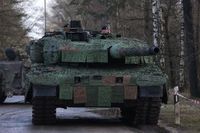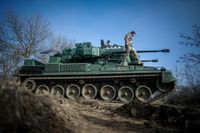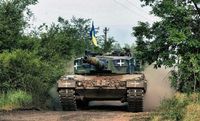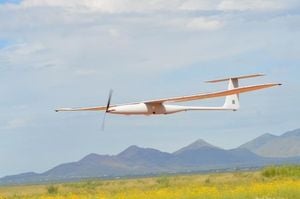In the ongoing conflict in Ukraine, the much-anticipated Leopard 2 tanks supplied by Germany are facing significant operational challenges on the battlefield. According to a classified transcript obtained by German media, these tanks, which arrived in Ukraine in 2023, are struggling to be effectively utilized due to a combination of technical vulnerabilities and logistical issues.
Germany has positioned itself as Ukraine's second-largest supplier of military equipment, following the United States. However, the delivery of the Leopard 2 tanks was marked by delays, as Chancellor Olaf Scholz's government hesitated for months before committing to send heavy weaponry to Ukraine, a decision that only came after the U.S. agreed to provide Abrams tanks. Despite their advanced technology, the Leopard 2 tanks have been noted to be vulnerable to drone strikes, a growing concern in modern warfare, as reported by The Telegraph.
Sergej Sumlenny, managing director of the Berlin-based European Resilience Initiative Center, pointed out that the main issue with the Leopard 2s is their limited numbers. “If one or two have to be repaired, that’s a big part of what Ukraine has that’s suddenly out of commission for a while,” he noted. The complexity of the tanks’ design has made battlefield repairs particularly challenging, often necessitating transportation to specialized repair facilities in western Ukraine or even Poland.
Ukrainian battalions are reportedly using the Leopard 2s primarily as artillery platforms rather than in their intended combat roles. Sumlenny emphasized that these tanks were not designed for the Ukrainian battlefield, stating, “They function well when they have good air support, but Ukraine is short on this.” The German design philosophy, characterized by over-complication, has also been criticized. According to Sumlenny, “Older systems, designed in the 1960s by those who actually saw war, are far more useful on the battlefield but have weaker armor.”
The limitations of the Leopard 2 tanks are echoed in a recent report from Germany’s own defense ministry, which describes the tanks as disappointing for Ukrainian crews. The assessment highlights that they are over-complex to operate and vulnerable to aerial attacks, severely restricting their range and mobility. Instead, they are being utilized as moderately mobile artillery pieces rather than the formidable tanks they were designed to be.
Ukrainian soldiers have expressed frustration over the performance of various German-supplied weapon systems. Internal documents obtained by Der Spiegel indicate that many of these systems, including the Panzerhaubitze 2000 self-propelled howitzer, are ill-suited for high-intensity warfare due to technical shortcomings. While the IRIS-T air defense system has been praised for its effectiveness, its costly and often scarce ammunition limits its operational value.
Furthermore, the newer Leopard 2A6 tanks require extensive maintenance, with reports indicating that rapid repairs near the frontlines are nearly impossible. The older Leopard 1A5 tanks, meanwhile, are used in a limited capacity due to inadequate armor protection. The mixed reviews extend to the Patriot missile system, which has been deemed unsuitable for wartime use due to aging carrier vehicles and a shortage of spare parts.
Despite the challenges, some German systems have fared better than others. The Gepard self-propelled anti-aircraft gun has received high praise from Ukrainian troops, who have labeled it the “most popular, efficient, and reliable” weapon in their arsenal. The Gepard units delivered to Ukraine were reactivated or sourced from other countries, proving effective in the current combat environment.
The experience of Ukrainian forces with the Leopard 2 tanks serves as a cautionary tale for Germany’s own military procurement strategies, particularly in light of potential Russian aggression against NATO. Sara Nanni, the defense spokesperson for the German Green Party, emphasized the need for a greater quantity of available systems, stating, “We can no longer think in such small quantities. We have to assume that vehicles have a long downtime after they’re damaged and simply need to be serviced.”
Similar maintenance and logistical problems have been reported with American Abrams tanks and British Challenger 2 tanks. Former U.S. National Security Adviser Jake Sullivan acknowledged in December 2024 that the Abrams tanks were “not the most useful piece of equipment” for Ukraine. Retired U.S. Army General Mark Hertling described them as “technological marvels” with “immense maintenance demands” and “enormous fuel consumption.” Ukrainian forces reportedly lost approximately 20 of the 80 Abrams tanks provided by the U.S. and Australia.
As the conflict continues, the performance of these advanced military systems raises critical questions about their effectiveness and suitability for the unique challenges faced by Ukrainian forces. The ongoing struggles with the Leopard 2 tanks, along with other German-supplied weaponry, highlight the need for a reassessment of military support strategies and the importance of adapting to the realities of modern warfare.
In summary, while the Leopard 2 tanks were heralded as a significant addition to Ukraine’s military capabilities, their operational shortcomings have led to a reevaluation of their role on the battlefield. As Ukraine continues to navigate these challenges, the lessons learned from these experiences may influence future military procurement and strategy not just in Ukraine, but across NATO nations as well.






